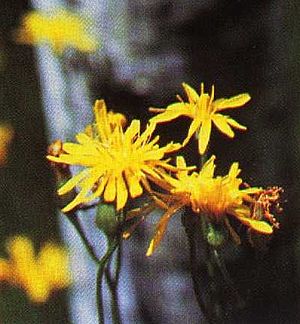Fiddleleaf hawksbeard facts for kids
Quick facts for kids Fiddleleaf hawksbeard |
|
|---|---|
 |
|
| Scientific classification | |
| Synonyms | |
|
Synonymy
Berinia runcinata (E.James) Sch.Bip.
Crepidium runcinatum Nutt Crepis alpicola (Rydb.) A.Nelson Crepis dakotana Lunell Crepis denticulata Rydb. Crepis glaucella Rydb. Crepis neomexicana Wooton & Standl. Crepis perplexans Rydb. Crepis tomentulosa Rydb. Hieracioides runcinatum (E.James) Kuntze Hieracium runcinatum E.James Psilochenia runcinata] Á.Löve & D.Löve Crepis andersonii A.Gray, syn of subsp. andersonii Crepis subcarnosa Greene, syn of subsp. andersonii Crepis barberi Greenm., syn of subsp. barberi Crepis mogollonica Greene, syn of subsp. barberi Crepidium caulescens Nutt., syn of subsp. glauca Crepidium glaucum Nutt., syn of subsp. glauca Crepis chamaephylla Wooton & Standl., syn of subsp. glauca Crepis glauca (Nutt.) Torr. & A.Gray, syn of subsp. glauca Hieracioides caulescens (Nutt.) Kuntze, syn of subsp. glauca Crepis aculeolata Greene, syn of subsp. hispidulosa Crepis obtusissima Greene, syn of subsp. hispidulosa Crepis pallens Greene, syn of subsp. hispidulosa Crepis petiolata Rydb., syn of subsp. hispidulosa Crepis platyphylla Greene, syn of subsp. hispidulosa Crepis riparia A.Nelson, syn of subsp. hispidulosa |
Crepis runcinata is a cool flowering plant found in North America. It is often called the fiddleleaf hawksbeard because of its unique leaf shape. This plant belongs to the daisy family, which means it's related to sunflowers and dandelions! You can find it growing across western and central Canada, the western and central United States, and even in northern Mexico.
Contents
What is Fiddleleaf Hawksbeard?
Crepis runcinata is a very adaptable plant. It can grow in many different places, from dry plains to mountain slopes. It is a perennial herb, meaning it lives for more than two years. This plant grows an upright stem that can reach about 80 centimeters (32 inches) tall. The stem is usually smooth and doesn't have many leaves or branches.
Leaves and Roots
The leaves of the fiddleleaf hawksbeard grow mostly around the bottom of the plant. They form a circle called a rosette. Each leaf is somewhat narrow and oval-shaped. They often have many triangular, tooth-like edges, but sometimes they are smooth. The plant has a strong taproot that helps it get water and nutrients from the soil.
Flowers and Seeds
The plant produces flower heads that look like small daisies. These heads have fuzzy, glandular parts called phyllaries around them. Inside, you'll see many bright yellow ray florets, which are like the "petals" of a daisy. Unlike some other daisy family plants, it doesn't have disc florets in the center. After the flowers bloom, they turn into small fruits called achenes. Each achene has a fluffy top called a pappus, which helps the seeds float away in the wind.
Different Types of Fiddleleaf Hawksbeard
Crepis runcinata is a very diverse species. This means it has many different types, called subspecies, that look slightly different or grow in specific areas. Here are some of them:
- Crepis runcinata subsp. andersonii is found in California and Nevada.
- Crepis runcinata subsp. barberi grows in Arizona, Nevada, New Mexico, and Chihuahua, Mexico.
- Crepis runcinata subsp. glauca is widespread across parts of Canada and many western US states.
- Crepis runcinata subsp. hallii is found in California and Nevada.
- Crepis runcinata subsp. hispidulosa grows in parts of Canada and several western US states.
- Crepis runcinata subsp. imbricata is found in Nevada and Oregon.
- Crepis runcinata subsp. runcinata is the most common type. It grows in many Canadian provinces and US states, including Colorado, Idaho, Minnesota, and Wyoming.
See also
 In Spanish: Crepis runcinata para niños
In Spanish: Crepis runcinata para niños

